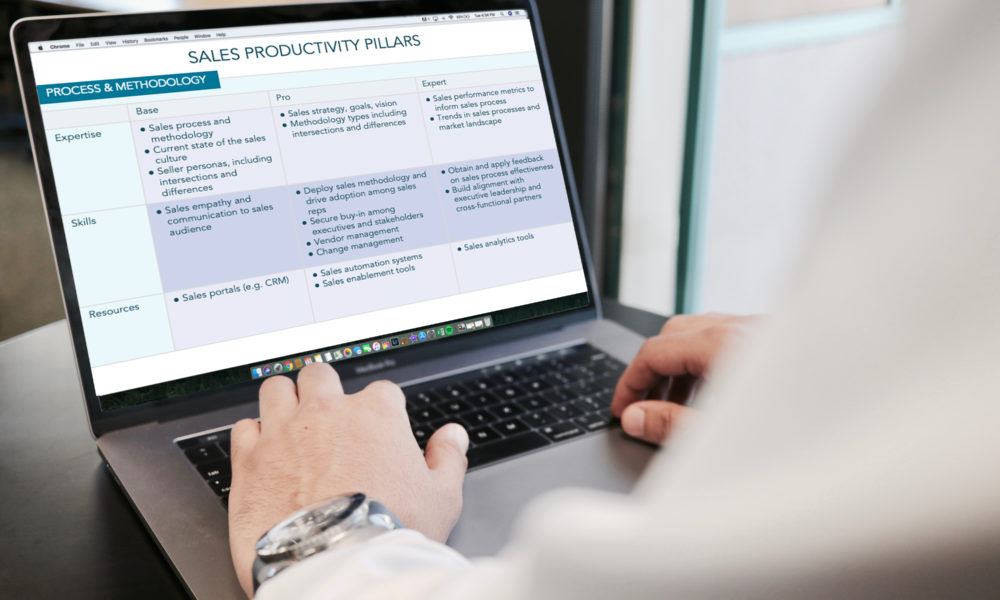Understanding Your Sales Methodology, Process, and Stages
3.8K Views | 14 Min Read
Consistency is becoming an increasingly vital trait across sales organizations today. With many sales organizations divided across multiple time zones, product lines, market segments, and more, being able to unite sales teams around a common approach to selling is key to reduce complexity and drive results.
The combination of an effective sales methodology, process, and stages can help create this unity. It provides salespeople with a complete guide on how to sell, from the behaviors and skills needed to effectively engage buyers to the key steps to take and when.
When these are aligned to an organization’s business priorities, product capabilities, and buyer behaviors, it can help organizations boost win rates, shorten sales cycles, and improve customer experiences. But to do this, sales enablement needs to be able to verify whether each is in place, validate that they are working, and make changes if not.
Methodology vs. Process vs. Stages: What’s the Difference?
Sales methodology, process, and stages are all closely related, but have important nuances. Understanding those differences is important to accurately assess the effectiveness of each and diagnose any problems that exist.
- The sales methodology is the structural framework that serves as a foundation for the sales process and stages. It is the philosophy for how to carry out the sales process through a repeatable, scalable, practical approach. Methodologies focus on developing the skills and tools needed to move certain stages in the sales process forward.
- The sales process is the repeatable sequence of steps that a salesperson takes to move a lead forward in their buying journey and ultimately win their business. While the methodology provides the framework for how to approach this, the process provides the map for how to apply it.
- The sales stages are the specific steps within the sales process. When defined properly, they should depict how far along a buyer is in their journey toward becoming a customer. Having clear definitions for each of these stages is critical for sales organizations to accurately forecast deals and manage pipeline.
“Every company has a sales process of some description, but not all will be underpinned by a sales methodology,” said Ben Cotton, sales enablement manager at Automation Anywhere.
However, all three are important to ensure the behaviors, actions, and approaches of salespeople are aligned with a common “why”, “how”, and “what”, and amplified across the sales organization. And simply having each is only the first step – sales enablement also needs to assess whether each are producing the desired results.
“Dig into the sales process to understand if it works and what could be improved,” said Cotton. “If you have a sales methodology in place, validate that it’s working. If it’s not, or if you don’t have one, reach out to vendors to learn more about their offering.”
Implementing a New Methodology
Evaluating, selecting, and rolling out a new sales methodology is a process that many sales enablement practitioners will find themselves responsible for at some point in their careers.
While this is definitely a need if the organization does not currently have a methodology in place, it may also become necessary if sales enablement uncovers issues with the methodology currently being used. For example, it might be misaligned with the reality of how customers engage with the organization, contradictory to the company culture or values, or simply lack adoption.
Finding the right methodology that fuels the sales process and creates harmony across the sales organization is important for success in the modern business environment. Here are three steps to ensure a smooth transition when implementing a new sales methodology.
1. Evaluate vendors and develop an implementation plan.
Selecting a methodology that complements the overarching business priorities and culture of the sales team is critical. In some organizations, this means it might be necessary to use different methodologies for different types of sales roles and teams.
“What we don’t want to have happen is that we introduce this methodology and the salespeople feel that it is so much of a departure from how they sell that it will never get off the ground,” said Glenn Clark, director of sales enablement at Smartsheet.
Successful implementation requires significant change management, so it’s important to have a solid plan that includes a realistic timeline and thoughtful communications plan to keep the process organized and steadily moving forward.
2. Secure buy-in and drive adoption
Buy-in of the sales methodology is needed across the organization, from executive leaders to frontline sales managers and the field. Invite executive leaders to help champion the process from the very beginning by involving them in the decision-making process. Then, ensure those leaders and managers are trained on the new methodology first so that they can better reinforce the new mindset across their teams. When communicating to the field, be sure to emphasize what is in it for them.
“The methodology will not get off the ground if leadership is not bought in and doesn’t understand what the methodology is,” said Clark. “And in order for the methodology to be used every day and top of mind, you have to have the managers able to speak to it, to coach to it, to drive the utilization of it through their teams.”
Remember: securing buy-in and driving adoption are not one-time events. This is an ongoing process that will require you to keep tabs on key metrics and consistently report on progress to maintain support.
3. Embed the methodology in the culture of the entire organization
Beyond just the sales organization, every facet of the business should be operating with the customer at the center of their activities. By concentrating everyone’s focus around a methodology, those approaches and behaviors can become part of the company-wide culture.
“A strong sales methodology is not just for the sales organization,” said Nicola Bain, director of global sales enablement at Infovista. “It is the whole organization, from the executive committee, research and development, product management. Everybody needs to understand the methodology for the value proposition that our solution delivers.”
This shared mindset also gives sales enablement clearer insight into sales efficiency and effectiveness, allowing practitioners to be more proactive in identifying areas of the business that can be improved.
Evaluating the Efficiency of the Sales Process
With a solid methodology in place, sales enablement needs to look into the sales process and assess what works, what doesn’t, as well as opportunities for further optimization.
“Sales process…is the way you account plan and think about winning customers for life,” said John Dougan, director of global sales and productivity at Workday. “The way you manage opportunities in terms of always adding value, always adding insight, understanding the goals, pressures, initiatives, obstacles of the organization you are selling into.”
Understanding of the effectiveness of this requires deep sales empathy. Sales enablement should seek to understand how sales reps’ daily workflows are impacted by the sales process, including their pain points, potential obstacles to productivity, and where the process could be streamlined. To gain this insight, consider taking the following steps:
- Observe sales reps. Take time to shadow salespeople as they prospect, conduct customer calls, and visit customers in the field. Seeing them in action gives you a clear, unbiased view of the struggles they might encounter, changes or emerging trends in the market, and common behaviors or skill gaps. While observing sales reps, keep in mind questions such as the following:
- What did the rep say or do to motivate the prospect to take a specific action?
- Did the prospect present objections that stalled the process? If so, was the rep able to resolve the objections with specific actions?
- Did the activity performed by the sales rep match the prospect’s expectations?
- Interview top, middle, and low performers. Give sales reps an opportunity to be candid with you and share their feedback – but ensure you seek this information from reps across all levels of performance to get a full picture of the dynamics at play. Aside from asking them for their perspective on what works and what doesn’t, dig deeper by reviewing deals with them one-on-one. Ask questions to uncover the actions that caused certain outcomes, such as:
- How long did it take to move from one step to another? Why?
- What activities took place in each step?
- How many touchpoints occurred before the prospect was ready to move forward?
- Ask your customers. Hearing the perspectives of your sales reps is certainly beneficial, but in order to truly understand whether the sales process is effective in moving prospects and customers forward in the buying journey, you need to go straight to the source. Identify a few key deals that were won as well as those that were lost among target personas. Seek to understand:
- What was their experience like working with your company/the sales rep?
- Why were they interested in your company’s solution?
- What pain points were they experiencing? Did the solution meet their needs?
Evaluating the Effectiveness of the Sales Stages
Within the sales process, the individual stages determine the criteria needed to progress a deal forward. If these are not clearly defined – or if they do not accurately reflect the actions buyers take in a given stage – it can lead to bottlenecks in the process that slow deal velocity, diminish forecasting accuracy, and limit pipeline growth.
Sales reps tend to be very optimistic when looking at their own pipeline, as CSO Insights reported that 47% think that sales reps are too subjective about close possibilities. Clearly defined, standardized criteria across sales stages helps minimize gray area between stages, making it easier to assess pipeline health, identify next steps to move deals forward, and report on progress.
“Sometimes reps will say, ‘it’s pending’ or ‘it’s close to closing’, things that are very wishy-washy,” said Brian Trautschold, chief operations officer at Ambition. “You want it to be simple, where they can say, ‘legal is reviewing it, so that’s the stage it’s in.’”
To analyze the effectiveness of the sales stages, look at the criteria in each stage through the following lenses:
- What should sales reps know at this stage? Define the knowledge needed at each stage from a technical perspective, skills perspective, as well as from the perspective of the customer. This will help you understand whether the right roles are focusing on the right stages and if there are knowledge gaps you need to fill. Put yourself in the shoes of the customer and consider what knowledge you would need to extract from the salesperson to move forward to the next stage of your journey.
- What should sales reps say at this stage? The communication methods a salesperson uses to engage a prospect or customer in the early stages of their buying journey will likely be different from those used toward the end. For example, early stages might be aimed at uncovering needs and require more probing questions while later stages might include complex negotiations that might require conflict management. Be sure each stage includes appropriate expectations for messaging, delivery, and activity.
- What should sales reps show at this stage? Similarly, the content shown in the earlier stages will often be vastly different from those shown in later stages. For example, criteria in an early validation stage might include an initial product demonstration, while a later stage might require visibility into pricing. Again, make sure the criteria in each stage matches what a customer or prospect would likely need to see to decide to move forward.
Often when companies implement sales methodologies, processes, and stages, they do so solely based on their own views rather than through the lens of the customer. However, the combination of both business objectives and the reality of customer behavior is essential to create the right recipe of methodology, process, and stage.
With a sales methodology, process, and stages that are tailored to how your business operates, how your salespeople work, and most importantly how your customers buy, you can help improve the consistency and quality of the customer experience.
















